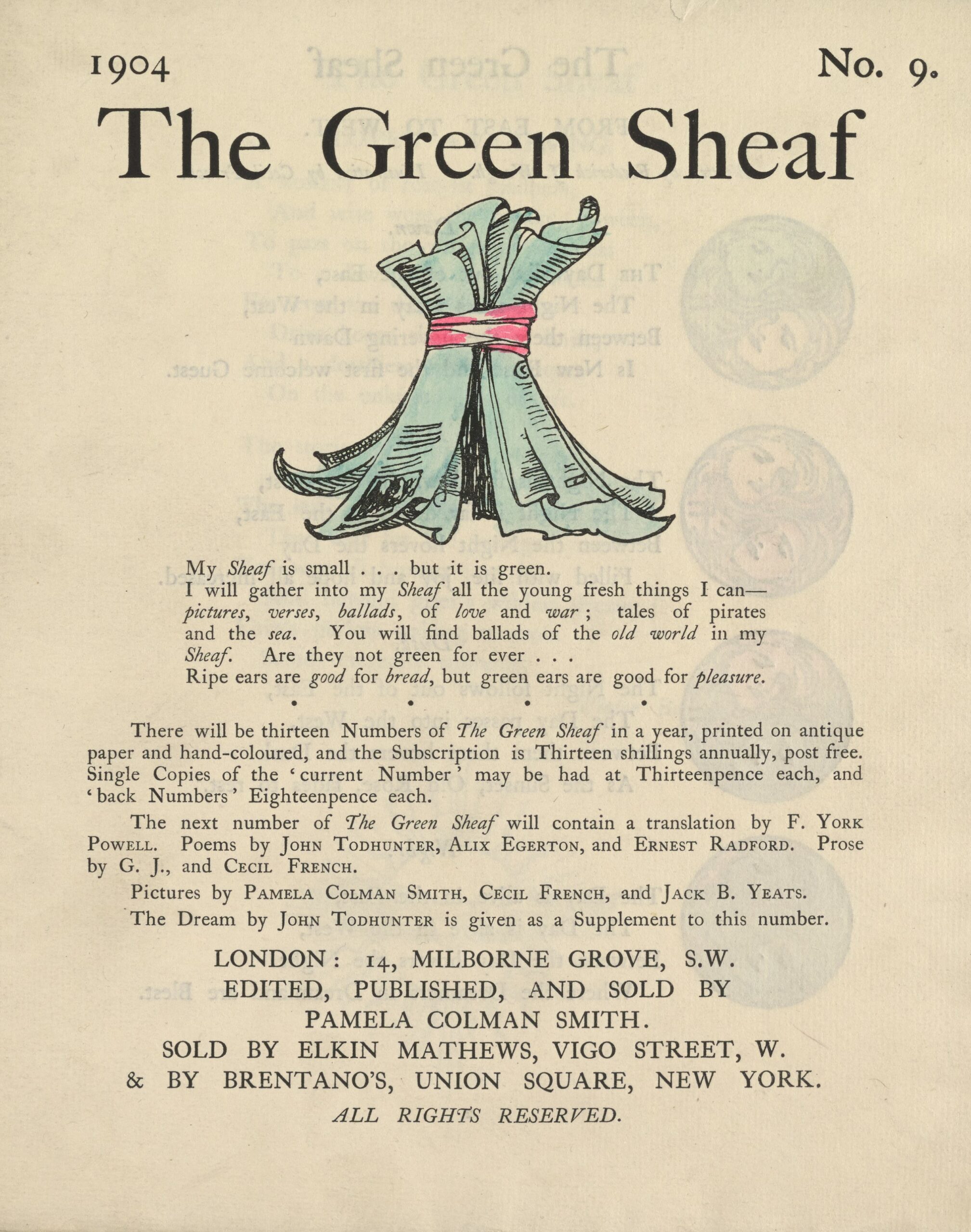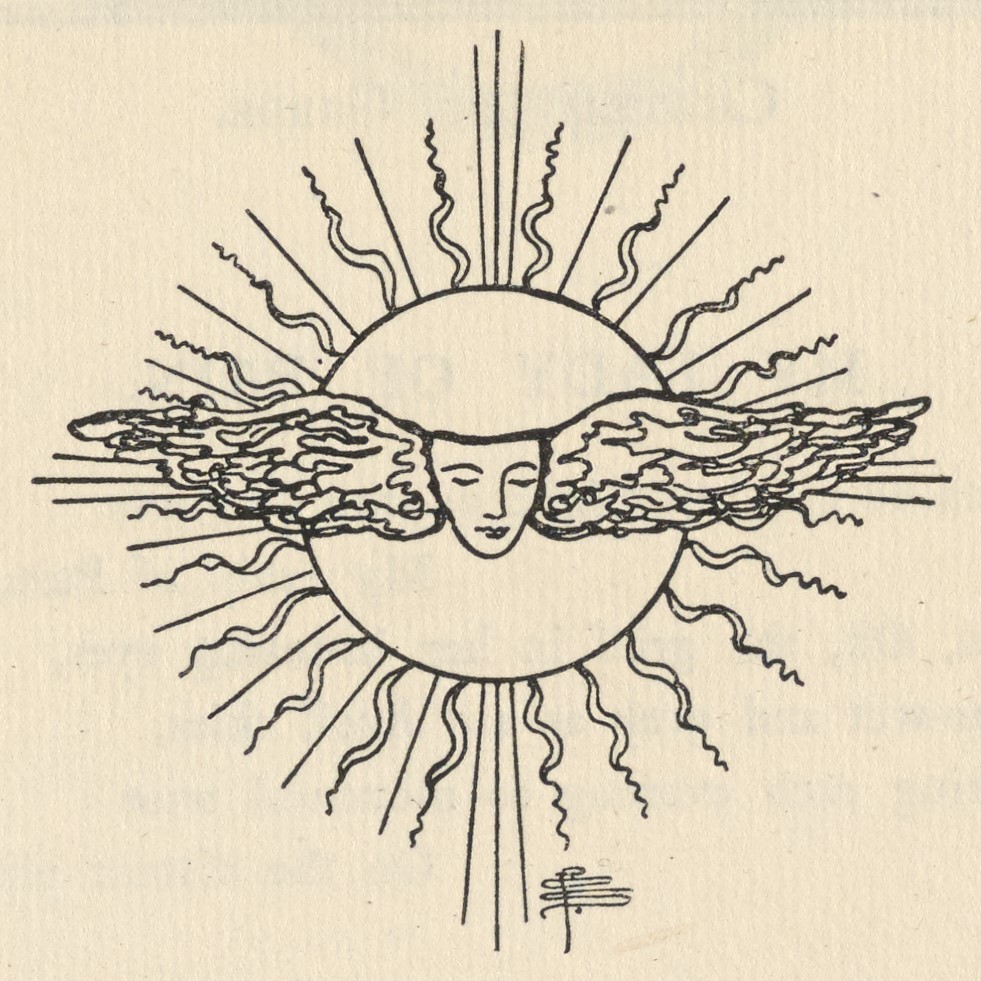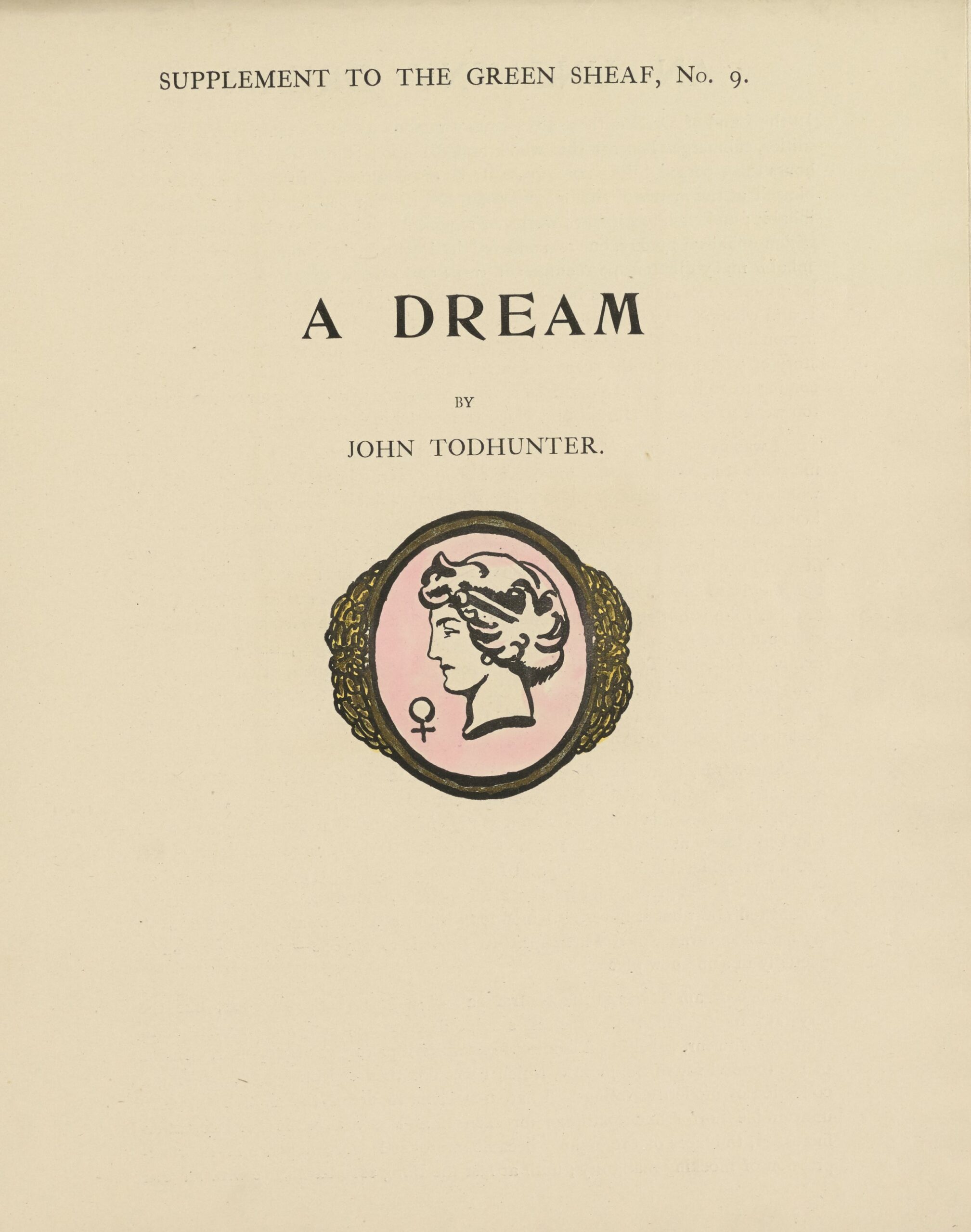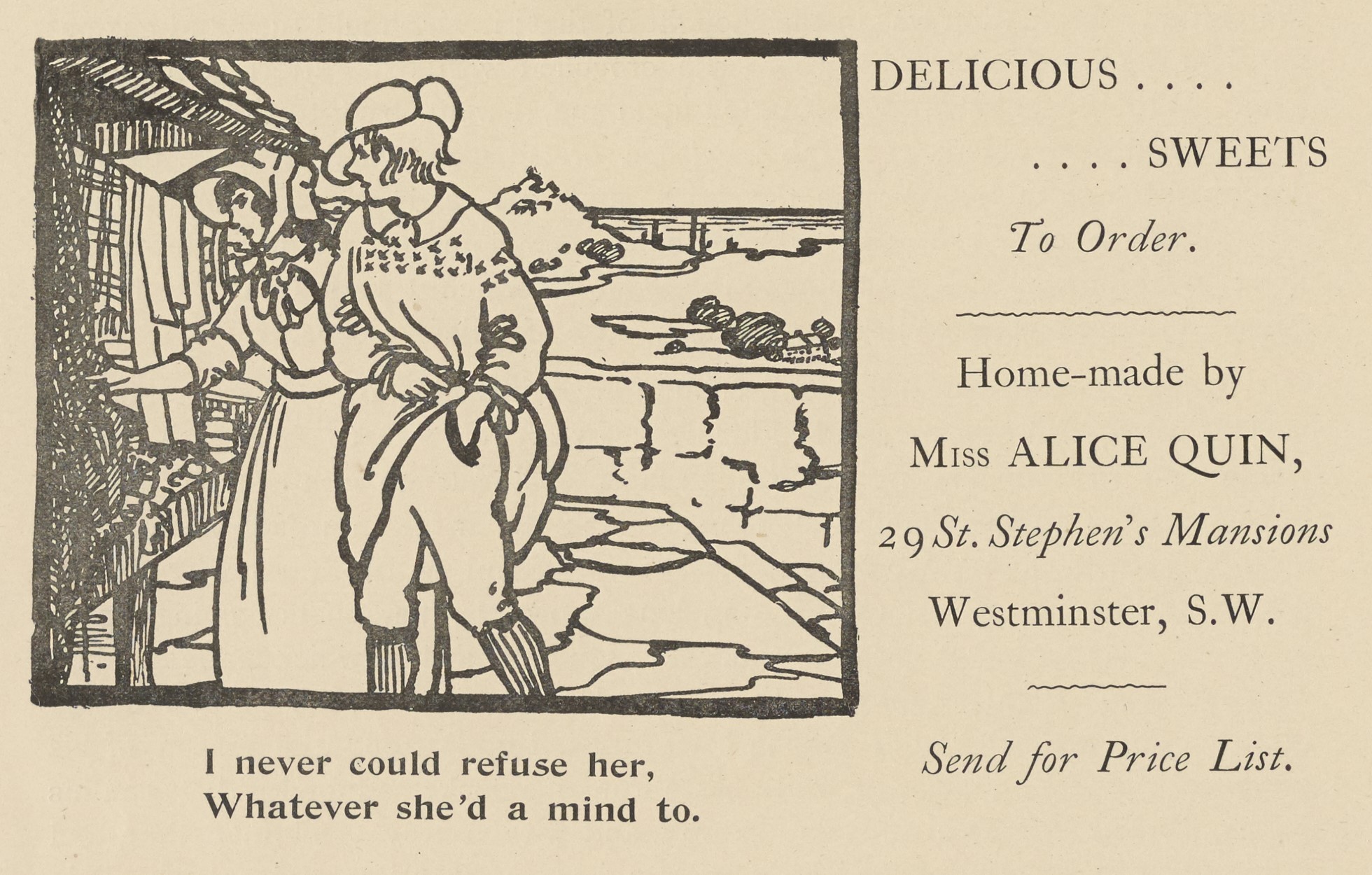TABLE OF CONTENTS
No. 9
Front Cover, by Pamela Colman Smith [i]
From East to West, by Frederick Waugh 2
Illustration by Cecil French 2
Love’s Awakening, by Victor Bridges 3
Illustration by Pamela Colman Smith 3
My Lady of Pain, poem by Alix Egerton 4-5
Chateau de Garde by W.T. Horton 4
Supplement. “A Dream,” by John Todhunter [i-iii]
Decorated title page [i]
Supplement Advertisements [iv]
Advertisement for Delicious Sweets, by Miss Alice Quinn, illustrated by Pamela Colman Smith [iv]
Untitled. [“The sky is very black”], by Mrs. [Anna] Barbauld 6
Illustration by Pamela Colman Smith 6
The Boat of Dreams, by Albert Bigelow Paine 7
Advertisements 8
FROM EAST TO WEST.
Written by Frederick J. Waugh. Illustration by Cecil French
Dawn.
The Day rises out of the East,
The Night sinks away in the West,
Between them the hovering Dawn
Is New Rose and the first welcome Guest.
Day.
The Night is far down in the West,
The Night is far down in the East,
Between the Night hovers the Day
Filled with life, joy and hope all increased.
Dusk.
The Night follows out of the East,
The Day passes into the West,
Between them there hovers the Dusk
As the Sunset, Old Rose, fades to rest.
Night.
The Day is alive in the East,
The Day is alive in the West,
Between the Day hovers the Night
Where the Dreamers in Dreamland are Blest.
LOVE’S AWAKENING.
A moment of rose-lit gladness,
And wise were the choice, I ween,
To pass on the wings of madness
To a dawn that breaks unseen;
For ever the dearest fingers
Drive home the crudest knife,
And a deathless passion lingers
On the unkissed lips of life.
The stories of withered ages
Are written in blood and tears,
The stain drips down to the pages
That wait for the younger years.
Yet over all human sorrow,
And beyond grief’s wildest dream,
Love’s pitiless waking morrow
Stands eternally supreme.
Victor Bridges.
MY LADY OF PAIN.
Pale as the moonlight on the sea, was
My Lady of Pain,
And, Oh, the grief in her haunting eyes,
Tear-wet and grey as are April skies,
Gazing each evening so mournful wise
On the distant plain.
The Green Sheaf
But the terraced walks and soft green lawns
Would her eyes pass by,
To there, where the rolling forest-land
Stretched out and away on either hand
To the plain which lay like a purple band
’Gainst the sunset sky.
She sat by the window looking west
At the twilight hour,
She held her knees in a long embrace
The shadows slanting across her face
Of the window-bars of this prison-place
In the castle tower.
In the closing dusk her eyes looked dark
As the purple sloe,
While a golden circlet bound her hair
Back from her brow, which was wondrous fair.
In the shadowed depths of her eyelids, there
Did she hide her woe.
Her lips were scarlet and spake no word
Of her heart’s distress;
And her neck was hung with chains of gold,
With gems of beauty and worth untold,
Half hidden in many a silken fold
Of her flowing dress.
So still she sat in the carven chair
In the growing gloom,
The lines of the arras never stirred
No sound of movement was ever heard,
Not a sigh or even a whispered word
In that silent room.
Some said her lover had played her false.
But their words were vain;
The deathless grief was, alas, her lot,
The longest pain in this life begot,
Pity her, love her, but blame her not,
My Lady of Pain.
Alix Egerton.
AN UNCANNY DREAM.
In the Land of Dreams there are as many regions as the dreamer has person-
alities, submerged beneath that which he looks upon as his own. In his waking
hours these personalities may apparently be fused into one. In his dreams he finds
himself at the mercy of the one dominant for the time, which he then seems to
inhabit; and each has its own world, or region, for the scene of its adventures̵a
region unknown by day, but remembered in dreams. One may for years fitfully inhabit
many different personalities in turn; and when a dream begins there may
be a moment of doubt and bewilderment, and the question is asked: “ ho am
I, and where am I?” But after a while the region grows familiar, and with it the
personality; and the dream-memory pieces together the sections of the serial
story of which this is the scene. I have had many of these serial dreams, some
coming to a climax, and then ceasing; others abortive, withering away like a plant
too weak to flower. Here is one which tormented me for years.
I was in the studio of an Italian artist in Rome, where, after he had shown
me some studies of his own, my eye fell upon a large picture, veiled by a curtain,
which stood on an easel in one corner. On my asking to be allowed to see it, he
looked at me for a moment, and I caught a slightly cynical expression in his eyes
and on his lips as he drew back the curtain. It was an Italian picture of the late
fifteenth century, in an elaborate frame of the same period: a Crucifixion, with
the Magdalen kneeling, or rather crouching, at the foot of the cross, and the Virgin
and St. John standing at either side. It was painted in the hard style, and some-
what crude colour, of a Ferrarese of the school of Mantegna, and much in the
manner of Cosimo Tura; and there was something grotesque in the naive repre-
sentation of suffering in the faces of Christ, the Virgin, and St. John; that of the
Magdalen was not seen. As I looked, the picture seemed to flicker, the figures
became indistinct, and the curtain was hastily drawn.
Afterwards, I saw the picture many times, in many dreams; in studios, on the
walls of old Italian palaces, in exhibitions in England; sometimes as a vague
vision, sometimes more distinctly; but always flickering in a tantalizing way when
I looked closely at the faces. I came to hate and dread it more and more; yet it
had a terrible fascination for me, and I was always trying to get possession of it.
Sometimes it was given me, sometimes I bought it, sometimes it came to me, I
cannot tell how; but it never remained long with me. It would disappear when
my back was turned, or if I attempted to show it to anyone—to reappear unex-
pectedly in some new place.
In one dream I was in the central hall of a great house of glass, like the
Crystal Palace. Off one of the aisles a double staircase, hung with scarlet cloth
trimmed with fur, led up to a landing from which a picture gallery opened. In one
of the rooms I found the picture, which I was not then expecting to see, among a
collection of modern paintings. I had now come to dread the sight of it, with
unutterable horror and loathing; for each time I saw it, while the fascination
increased, the faces of the figures became more and more horrible in their ex-
pression of mocking malignity; until at last the thing seemed to live with an evil
life—a vile and blasphemous caricature of the tragedy of Redemption, in which
the parts were played by devils. The Magdalen’s face was still unseen; but I felt
that the last horror was yet to come—if she should look round? The secret of
the picture’s fascination was in the thought of that; if she should turn and gaze at
me from the foot of the cross, where she crouched with her glittering, flickering
hair! With this mysterious fascination upon me, I went back to the first room,
where I had seen a clerk at a table, with a priced catalogue. I spoke to him,
described the picture, asked him the price, and was ready to offer anything to
secure it. He seemed surprised, assured me there was no such picture in the exhibi-
tion; and I hurried back with him to the room in which I had seen it. It was
gone; and in its absence I felt an ecstatic sense of relief—escape.
At last, in a subsequent dream, I found myself rushing over the sea on the
back of a huge sea monster, and suddenly I saw, sitting face to face with me, a
young man with a handsome dark Italian face, looking at me with lustrous amber-
brown eyes out of the shadow of a huge black hat with upturned brim. His
dark-brown hair fell in crisp curls to his shoulders, and he wore a rather shabby
jerkin and breeches of black velvet, and long brown leather boots coming up to
his knees. He looked at me with a mocking smile on his lips, which made his dark
moustache curl slightly upward at the ends. He was, I knew, the painter of the
picture; and without a word passing between us, 1 understood the reason of his
presence. He took a piece of white paste from his pocket, rubbed it between his
palms, worked it with his fingers like wax, and with a tiny steel modelling-tool
fashioned it into a kind of medallion, with a face—a beautiful woman’s face—in
profile upon it. This he set in an antique gold ring, which he put on my finger.
Then the scene changed. I was in a gloomy pine-forest, which I knew to be
the Pineta of Ravenna. I knew also that the ring would lead me to the
picture. The moon was somewhere, but not visible, and I was oppressed by the
gloom of the forest. I forced my way through a dense underwood of bushes and
young pines, and at last came to the mouth of a cavern, absolutely dark, and full
of sulphurous vapour. Into this I plunged, and after struggling on for a fearful
time, half smothered by the fumes, I saw a gleam of light in the distance, and at
length came out upon the shore of the Adriatic, and felt the cool night air once
more. Upon a patch of smooth grass at the edge of the sandy beach, over which
tiny waves were lazily rippling, I saw a little chapel with a gabled belfry, dark
against the sky, where the moon shone through light clouds. I was drawn by some
hideous fascination to this chapel, which stood north and south, not east and west.
The door was at the southern end, and was locked and bolted. I felt that if I
were to touch the bolts with the ring, the door would open, and I should be
delivered into the power of the picture. My hand moved of itself to touch them;
but I made a last despairing effort, tore off the ring, and flung it away.
I then woke, with these verses vivid in my memory, and at once wrote them
down, with the date of the dream: “Night of Aug. 29th, 1895.”
I knew that if I dreamed it to the end
That dream were death—I knew that if I saw
The face that faltered as I did contend
With swimming vapours in the cavern’s maw,
That sight were—
JOHN TODHUNTER.
A PORTRAIT OF W. B. YEATS,
From a Drawing by Pamela Colman Smith.
A Photogravure Plate has been made, and a limited Edition of
50 Proofs on India Paper (signed) price 15s. nett, post free. Prints
from the plate, 2s. 6d. nett, post free. To be obtained from the
Editor of The Green Sheaf
The GREEN SHEAF for 1904.
The sky is very black; the rain pours down. Well, never mind it;
we will sit by the fire, and read, and tell stories, and look at pictures.
Where is Billy, and Harry, and little Betsey? Now tell me who can
spell best. Good boy! There is a clever fellow Now you shall
all have some cake.
Mrs. Barbauld.
THE BOAT OF DREAMS.
Once there were two happy children. They were very happy,
for they had no care.
All day they played on the sands of a bright river that came out
of the blue sky to the east and flowed into the sky of the west, where
evening turned it to a river of gold.
And often as they played the children talked of a wonderful boat
that would some day come to take them down this bright river. It
would not be like other boats, but, as the river was a dream river, so the
boat would be a boat of dreams, with a sail of light, and they would
only have to sit in the magic boat and be borne along and along by
the fair blue tide that came out of the sweet meadows of morning.
Always they talked of the wonderful River Boat, and always they
waited for it as they played, free from care, on the bright sands.
And lo, one day, a day of dreams, when a haze lay upon the water
and all the fields were still, they suddenly saw their River Boat coming.
And they watched without speaking, fearing it might pass them by.
Nearer and nearer it came, and it did not pass, but came quite to
the shore, all so gently and silently, as they had dreamed.
And the two happy children stepped on board the River Boat and
sat side by side, saying no word, but wonderfully happy (being free from
care) because their boat of dreams had come for them at last.
And the sail of the magic River Boat was filled with light, and they
were borne away. Side by side, in happy silence, they were borne down
the bright river. In their boat of dreams the happy children of fancy
sailed on and still on, to a fair land that lies through the gates of evening,
where all our dreams become realities, and all our realities dreams.
Albert Bigelow Paine.
BLAKE’S PROPHETIC BOOKS
EDITED BY
A. G. B. Russell & E. R. Maclagan.
JERUSALEM.
Cr. 4to, 6/- net.
A. H. Bullen, 47, Great Russell Street,
London, W.C.
HAND COLOURED PRINTS by Pamela Colman Smith, of
Miss Ellen Terry:—
as “Nance Oldfield” … Price Is. Post free.
as “Meg Page” … … ” Is. ”
as “‘Portia’ hurrying to
the Railway Station” … ” Is. ”
as “Sans Gêne” … … ” Is. ”
as “Queen Katharine” … ” 2s. 6d. ”
as “Mistress Page” … ” 2s. 6d. ”
as “Hiördis” (in the
Vikings) … … … ” 2s. 6d. ”
Subscribers to The Green Sheaf may obtain “Hiördis”
for Is. Post free.
⎯
THE GALLERY,ONE PRINCE’S TERRACE, HEREFORD ROAD,W.
JOHN BAILLIE requests the honour of a visit. Exhibitions every three weeks.
A fine Collection of Modern Jewellery always on view.
Classes for Enamelling, Metal-work, Carving, Bookcasing, Water Colours, Fan
Painting, Wood Engraving, &c.
Gallery open 10.30 a.m. to 6 p.m.
⎯
From ELKIN MATHEWS’ LIST.
THE WINGLESS PSYCHE. (Essays) By Morley Roberts. Author of “Rachel
Marr.” Fcap. 8vo, 2s. 6d. net.
“The writing is supple and sparkling.”—Times.
“Exquisitely written, tinged with philosophic melancholy.”—Vanity Fair.
CALENDARIUM LONDINENSE 1904, or the London Almanack for the
Year 1904. Fine etched Plate “The Hall of Clifford’s Inn,” by William Monk, R.E.,
15½ by 11½.
2s. 6d. net.
RECOLLECTIONS OF DANTE GABRIEL ROSSETTI AND HIS CIRCLE.
Cheyne Walk Life. By the late Henry Treffry Dunn. Edited and Annotated by Gale Pedrick,
with a Prefatory Note by W. M. Rossetti. Photogravure and other Illustrations. Cr.
8vo, 3s. 6d. net.
NOTES FROM A LINCOLNSHIRE GARDEN. By A.L.H.A. Cr. 8vo, 3s. 6d.net.
“The writer is evidently a keen observer of nature.”—Morning Post.
“There is a quite particular attraction about this volume.”—Daily News.
THE GOLDEN HELM AND OTHER VERSE. By Wilfrid Wilson Gibson,
Fcap. 8vo, 2s. 6d. net.
“Words and thought move together in noble harmony, and the work is the outcome of
passion and imagination, controlled by a
wise artistic restraint.”—Glasgow Herald.
FIRES THAT SLEEP. By Gladys Schumacher. Cr. 8vo, 3s. 6d. net.
YEATS’ (JACK B.) Plays in the Old Manner, viz., “James Flaunty, or the Terror
of the Western Seas,” and the “ Scourge of the Gulph,” Both illustrated by the Author.
Together with
a miniature presentation plate portrait of R. L. Stevenson, by W. Strang. In a picture
envelope, 2s. net.
THE SEASONS WITH THE POETS. An Anthology edited by Ida
Woodward. Pott 4to, 5s. net.
“The wideness of the range adds to the charm of the selections.”—Court Journal.
New Volumes in the Vigo Cabinet Series. Royal 16mo, Is. net each.
BALLADS. By John Masefield. Author of “ Salt Water Ballads.”
“Full of that grimness of adventure that comes nowadays to save romance from mere
ethereal dissipations.”—Manchester Guardian.
“Brave ballads with a line swing.”—Academy.
DANTESQUES, a Sonnet Companion to the Inferno. By George A. Greene,
THE LADY OF THE SCARLET SHOES, and other Verses. By Alix Egerton.
⎯
London: ELKIN MATHEWS, Vigo Street, W.
MLA citation:
The Green Sheaf, No. 9, 1904. Green Sheaf Digital Edition, edited by Lorraine Janzen Kooistra. Yellow Nineties 2.0, Toronto Metropolitan University Centre for Digital Humanities, 2022. https://1890s.ca/gsv9_all/






